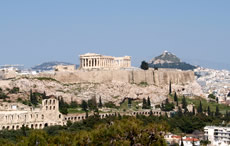>> TOP 10 Of ATHENS GREECE
>> TOP 10 Around ATHENS
>> TOP Destinations from ATHENS
Meteora
Santorini







Early human occupation
The earliest artifacts date to the Middle Neolithic era, although there have been documented habitations in Attica from the Early Neolithic (6th millennium BC ). Once into the Bronze Age , there is little doubt that a Mycenaean megaron must have stood on top of the hill, housing the local potentate and his household, guards, the local cult facilities and a number of workshops and ordinary habitations. The compound was surrounded by a thick Cyclopean circuit wall, possibly between 4.5 m and 6 m in height, consisting of two parapets built with large stone blocks and cemented with an earth mortar called emplekton. The wall follows typical Mycenaean convention in that its gate was arranged obliquely, with a parapet and tower overhanging the incomers' right-hand side, thus facilitating defence. There were two lesser approaches up the hill on its north side, consisting of steep, narrow flights of steps cut in the rock. Homer is assumed to refer to this fortification when he mentions the "strong-built House of Erechtheus " (Odyssey 7.81). It was during that time that an earthquake caused a fissure near the northeastern edge, one that ran all the way down to the marl layer and in which water collected. An elaborate set of stairs was built and the well was used as a protected source of drinking water during some portion of the Mycenaean period, as it was invaluable in times of siege.
The Dark Ages
The imagined intact Acropolis in an 1846 painting by Leo von Klenze
Most of the major temples were rebuilt under the leadership of Pericles during the Golden Age of Athens (460-430 BC). Phidias , a great Athenian sculptor, and Ictinus and Callicrates two famous architects, were responsible for the reconstruction. During the 5th century BC , the Acropolis gained its final shape. After winning at Eurymedon in 468 BC ,Cimon and Themistocles ordered the reconstruction of southern and northern walls, and Pericles entrusted the building of the Parthenon to Ictinus and Phidias.
In 437 BC Mnesicles started building the Propylaea , monumental gates with columns of Penteli marble , partly built upon the old propylaea of Pisistratus. These colonnades were almost finished in the year 432 BC and had two wings, the northern one serving as picture gallery. At the same time, south of the propylaea, building of the small Ionic Temple of Athena Nike commenced. After an interruption caused by the Peloponnesian War , the temple was finished in the time of Nicias ' peace, between 421 BC and 415 BC.
During the same period the building of the Erechtheum , a combination of sacred precincts including the temples of Athena Polias, Poseidon , Erechtheus , Cecrops , Erse , Pandrosos and Aglauros, with its so-called the Kore Porch (or Caryatids ' balcony), was begun.
Between the temple of Athena Nike and the Parthenon there was the temenos of Artemis Brauronia or Brauroneion , the goddess represented as a bear and worshipped in the deme of Brauron. The archaic xoanon of the goddess and a statue made by Praxiteles in the 4th century BC were both in the sanctuary.
Behind the Propylaea, Phidias' gigantic bronze statue of Athena Promachos ("she who fights in the front line"), built between 450 BC and 448 BC , dominated. The base was 1.50 m high, while the total height of the statue was 9 m. The goddess held a lance whose gilt tip could be seen as a reflection by crews on ships rounding Cape Sounion , and a giant shield on the left side, decorated by Mys with images of the fight between the Centaurs and the Lapiths . Other monuments that have left almost nothing visible to the present day are the Chalkotheke , the Pandroseion , Pandion's sanctuary , Athena's altar, Zeus Polieus's sanctuary and, from Roman times, the circular temple of Augustus and Rome .
Archaeological remains
The entrance to the Acropolis was a monumental gateway called the Propylaea . To the south of the entrance is the tiny Temple of Athena Nike . A bronze statue of Athena, sculpted by Phidias , originally stood at its center. At the centre of the Acropolis is the Parthenon or Temple of Athena Parthenos (Athena the Virgin). East of the entrance and north of the Parthenon is the temple known as the Erechtheum . South of the platform that forms the top of the Acropolis there are the also the remains of an outdoor theatre called Theatre of Dionysus . A few hundred metres away, there is the, now partially reconstructed Theatre of Herodes Atticus .



The Acropolis of Athens is the best known acropolis (high city, The "Sacred Rock") in Greece and in the world. Although there are many other acropoleis in Greece, the significance of the Acropolis of Athens is such that it is commonly known as the Acropolis without qualification.
The Acropolis was formally proclaimed as the pre-eminent monument on the European Cultural Heritage list of monuments on the 26th of March, 2007. The Acropolis is a flat-topped rock which rises 150 (512 ft ) above sea level in the city of Athens , Greece .It was also known as Cecropia, after the legendary serpent -man, Kekrops or Cecrops , the first Athenian king.















